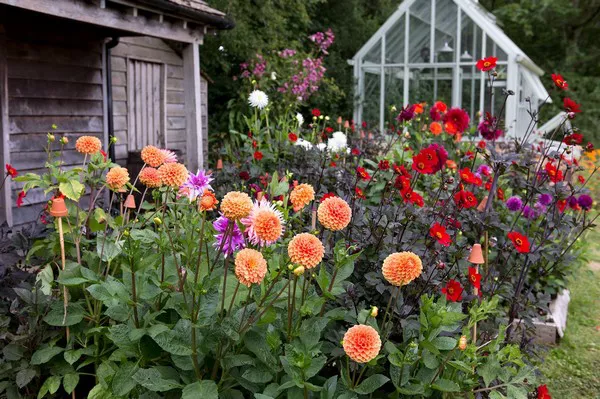Flowers are nature’s exquisite works of art, fascinating us with their unique shapes, colors, and fragrances. They play a significant role in our lives, from adorning our gardens and homes to symbolizing emotions and events. The world of flowers is vast and diverse, with countless species and varieties to explore.
Wildflowers
Wildflowers are untamed, native flowers that grow in their natural habitats without human cultivation. They have a charm all their own, often with delicate and unique characteristics. Some well-known wildflowers include the California Poppy, Bluebonnet, and Indian Paintbrush. These flowers can be found in various ecosystems, from meadows and forests to deserts, making them an essential part of the natural world.
Perennials
Perennial flowers are a beloved category among gardeners. These are flowers that return year after year, making them a sustainable and low-maintenance choice for any garden. Examples of perennial flowers include the elegant Peony, vibrant Daylily, and the fragrant Lavender. Perennials come in a wide range of colors, sizes, and shapes, allowing for endless garden design possibilities.
Annuals
Annual flowers have a shorter lifespan, typically completing their life cycle in one growing season. However, they make up for their brevity with a burst of vibrant colors and rapid growth. Marigolds, Petunias, and Zinnias are popular examples of annual flowers. Gardeners often use them to add seasonal variety to their gardens, as these flowers provide continuous blooms from spring to fall.
Bulbs
Bulb flowers, also known as geophytes, have a unique underground storage structure called a bulb. Daffodils, Tulips, and Hyacinths are famous examples of bulb flowers. These plants are known for their early spring blooms, bringing a splash of color to gardens after the winter dormancy. Bulbs are prized for their ability to multiply, creating impressive displays over time.
Roses
Roses are perhaps the most iconic and revered flowers worldwide. Known for their timeless beauty and rich symbolism, they come in a wide array of colors and fragrances. Varieties of roses include the classic Red Rose, the delicate Tea Rose, and the stunning Climbing Rose. Roses are cherished for their role in expressing love and emotions, making them a popular choice for gifts and special occasions.
Tropical Flowers
Tropical flowers are known for their exotic beauty and vibrant hues. They thrive in warm and humid environments and are often associated with paradise and luxury. Orchids, Bird of Paradise, and Plumeria are stunning examples of tropical flowers. These blooms are prized for their intricate shapes and bold colors, making them a favorite choice for tropical-themed events and decorations.
Herbaceous Flowers
Herbaceous flowers are characterized by their soft, non-woody stems. They are often chosen for their culinary, medicinal, or aromatic properties. Popular herbaceous flowers include the cheerful Sunflower, the fragrant Lavender, and the flavorful Chrysanthemum. These flowers not only provide aesthetic beauty but also have practical uses, enhancing gardens and homes alike.
Shrubs and Bushes
Shrubs and bushes offer a wide variety of flowering plants that come in various sizes and shapes. They are particularly popular for creating hedges and privacy screens. Some examples of flowering shrubs include the versatile Rose of Sharon, the delicate Lilac, and the evergreen Azalea. These plants bring color and structure to gardens year-round.
Climbing and Trailing Flowers
Climbing and trailing flowers are known for their ability to gracefully cover fences, walls, and trellises. They add a vertical dimension to gardens and are often grown for their visual appeal and fragrance. Notable examples include the cascading Wisteria, the charming Clematis, and the iconic Ivy. These flowers are a great choice for adding a touch of romance to any garden.
Native and Indigenous Flowers
Native and indigenous flowers are specific to particular regions or countries. They are vital for maintaining local ecosystems and are often cherished for their cultural significance. Examples include the Texas Bluebonnet, the Japanese Cherry Blossom, and the Australian Kangaroo Paw. These flowers reflect the unique beauty and biodiversity of their respective regions.
Exotic and Rare Flowers
Exotic and rare flowers captivate with their extraordinary features, often found in remote and unexplored corners of the world. Some examples include the peculiar Corpse Flower, the striking Rafflesia, and the ethereal Ghost Orchid. These flowers are highly sought after by collectors and enthusiasts due to their uniqueness and scarcity.
Edible Flowers
Edible flowers serve both culinary and aesthetic purposes. They can be used as garnishes in salads, desserts, and beverages. Popular edible flowers include the vibrant Nasturtium, the sweet Viola, and the aromatic Basil Blossom. Their delightful flavors and colors add a creative touch to dishes, making them a favorite among gourmet chefs and home cooks.
Conclusion
The world of flowers is a boundless realm of diversity, offering a wide array of colors, shapes, fragrances, and uses. From the simplicity of wildflowers to the grandeur of tropical blooms, flowers enrich our lives in countless ways. Whether you’re a passionate gardener, a nature enthusiast, or someone who appreciates the beauty of a fresh bouquet, the many types of flowers allow you to explore, appreciate, and celebrate the wonders of the natural world. As we’ve seen, each type of flower has its unique charm and significance, making the world of flowers a continuous source of inspiration and delight.


